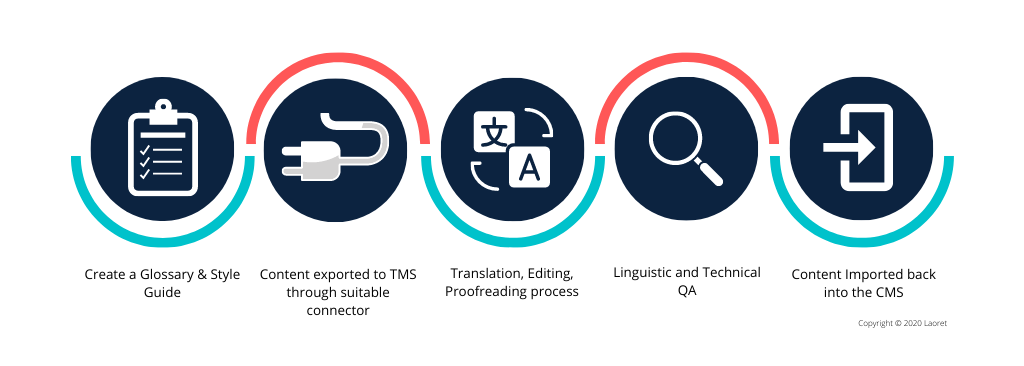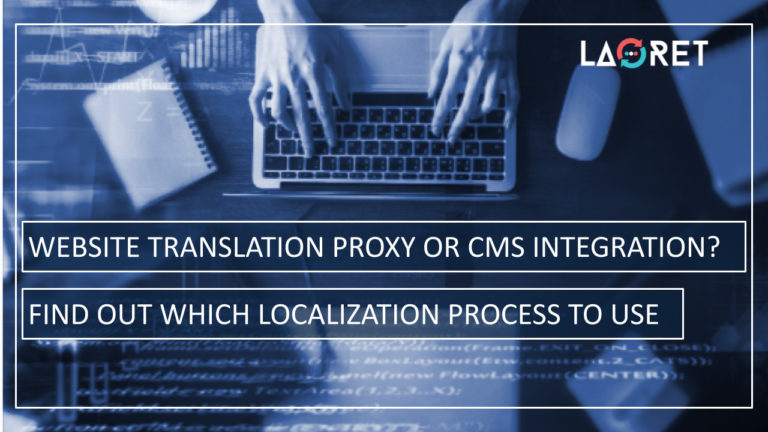Website Translation Proxy Or CMS Integration? Find Out Which Localization Process To Use
If you want to take your business and product global, translating your website is a crucial part of the process. But how do you know which strategy to follow? Do you need a standard website localization with CMS integration? Or will you benefit more from this Translation proxy you have been hearing so much about?
It is true that Translation Proxy is gaining in popularity. But can popularity be the only indicator of the true value of an approach? In this post, we would like to set the record straight and offer you a real insight into which way to go with your website to ensure global engagement.
What Is A Translation Proxy And How Is It Different From A CMS-Integration Website Localization?
The Website Localization Process With A CMS Integration
The normal website localization process localizes the website through a back-end method with the use of a connector between your Content Management System (CMS) and the Language Service Provider’s (LSP) Translation Management System (TMS). The content will be exported to the TMS, the assigned linguists will translate the content with Translation (CAT) Tools, after which it will be submitted to a linguistic Quality Assurance (QA) and assigned to the Localization Engineer to fix any possible bugs.
Pro Tip! Laoret offers integrations between your CMS and our specialized TMS.
Both technical and linguistic expertise should be integrated in the website localization process. Due to its complexity, this approach also requires the client to set up content guidelines through:
- A Style Guide, which includes stylistic guidelines on writing, formatting, and design to maintain consistency in the brand message.
- And a Glossary that includes a master list of terms and definitions, expanding on what the terms mean, how they should be translated, and whether they should be translated at all.

| Pros of CMS Integration | Cons of CMS Integration |
| CMS allows for a higher level of flexibility and customization with translations.
Clients can review translations on the server prior to publication. Multiple teams from multiple regions can contribute to CMS localization without restrictions New technologies can be integrated easily. |
CMS integration can be rather pricey because of the high levels of customization and configuration.
A large number of multilingual sites that are handled manually can easily fall out of sync with each other and be time-consuming to manage. When publishing new content on the source page, errors can occur on the global site. Updates will need to be revised and reported, which will ideally include in-depth Quality Assurance processes. |
Website Translation Proxy

The Pros Of Translation Proxy
- Sometimes when dealing with SaaS or a web-based application localization, there can be difficulties and bugs that affect the performance. The same can happen with a CMS that is not designed to be translation-friendly. Since with the Translation Proxy, the database itself doesn’t have language added and it exists on a different server, the performance of your original website will not be compromised in any way.
- The process of Continuous Localization is a lot less complex. Changes are optimized with an automated detection ability, so updates are translated immediately and shown to users instantly even without a translation-friendly platform.
- Translation proxy can be cost-effective, although that does depend on the provider, to what degree you will customize your system, and if you need to opt for additional storage. In order to keep costs down, options such as GoogleAppEdge work on the principle similar to the prepaid phone cards where you only pay for what you use instead of applying for a set monthly superscription rate.
- Translation proxy was not indexed in the past, so this used to be an argument on the other side. But now, translations hosted on a third-party server will also be indexed if you apply the correct settings.1
The Cons Of Translation Proxy: When A CMS Integration Suits You Better
- You do not own the multilingual content because essentially, it is not hosted on your server. This means that Translation Proxy is an investment without ownership where you will need to pay a monthly subscription fee if you wish to keep the hosted content.
- Will your site require any substantial alterations to the colors, layout or style? Then you may want to think twice about requesting Translation Proxy. In this case, you will need Desktop Publishing (DTP) services, where the layout will be localized according to local expectations in terms of design.
- Similarly, if you require significant changes to your translation to your web content and marketing content. This would require two different versions of your website. Translation Proxy works best when you need to create a “multilingual mirror†of your site, and all the content will remain largely the same.
- If you have a dynamic website with multiple contributors and stakeholders, a Translation Proxy won’t make the cut. You will need a high level of customization that can only be achieved through specialized website localization services.

Conclusion
Do you have a complex website that will require very targeted translations, customized designs, and unique messaging for each locale? Then you will benefit most from a standard website localization, however, if you are looking for more of a mirrored version of your pages and don’t mind paying a subscription basis, Translation Proxy might be the ideal strategy for you.
At Laoret, we are committed to providing the service that is best for you. This means that we will always advise you on the best road to take. We offer specialized website localization services provided by native, in-country linguists and tech-savvy localization engineers. If your strategy demands Translation Proxy rather than a full-scale website localization, we will provide you with the best plan of action moving forward.
That is why at Laoret, we hire in-country, native professionals who possess targeted subject matter expertise. We leverage the latest translation technologies to ensure translation quality as well as speed and apply rigorous QA on every level. Contact us and get a free quote for your next localization project and take the first step in developing a localization business strategy!






